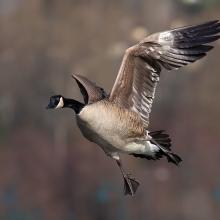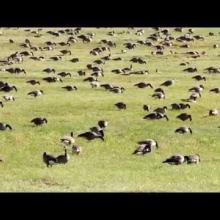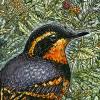

Join BirdNote tomorrow, November 30th!
Illustrator David Sibley and actor H. Jon Benjamin will face off in the bird illustration battle of the century during BirdNote's Year-end Celebration and Auction!
Autumn…and geese fly high overhead in V-formation. But what about that V-formation, angling outward through the sky? This phenomenon — a kind of synchronized, aerial tailgating — marks the flight of flocks of larger birds, like geese or pelicans. Most observers believe that each bird behind the leader is taking advantage of the lift of a corkscrew of air coming off the wingtips of the bird in front. This corkscrew updraft is called a tip vortex, and it enables the geese to save considerable energy during long flights. The V-formation may also enhance birds’ ability to see and hear each other, thus avoiding mid-air collisions. Small birds probably do not create enough of an updraft to help others in the flock and don’t fly in vees.
BirdNote®
Geese in V-Formation: Tailgating?
Written by Bob Sundstrom
This is BirdNote!
[Sounds of migrant — not resident — flock of Canada Geese flying over]
Among the most evocative sounds of early autumn are the voices of migratory geese, flying high overhead in V-formation. The migrating Canada Geese heard here are returning from nesting in Canada and Alaska. [Repeat sounds of migrant — not resident — Canada Geese flock flying over]
But what about that V-formation, angling outward like a ship’s wake through the sky? This phenomenon — a kind of synchronized, aerial tailgating — marks the flight of flocks of larger birds, like geese or pelicans, but isn’t seen in smaller birds like robins or sandpipers.
Most observers believe there is a straightforward reason for flying in a V. Each bird behind the leader is taking advantage of the lift of a corkscrew of air coming off the wingtips of the bird in front. This corkscrew updraft is called a tip vortex. Such efficiency enables the geese to save considerable energy during long flights.*
The V-formation may also enhance birds’ ability to see and hear each other, thus avoiding mid-air collisions. So migrating birds that do form V-formations combine the benefits of aerial updrafts and communication.
Small birds probably do not create enough of an updraft to help others in the flock and don’t fly in V-formation. [Individual members of the Canada Geese flock flying over]
Learn more about the aerodynamics of flight on our website, birdnote.org. I’m Michael Stein.
###
Bird sounds provided by The Macaulay Library at the Cornell Lab of Ornithology, Ithaca, New York. Large flock recorded by W.W.H. Gunn, individuals by G.B.Reynard.
Ambient sound provided by C. Peterson.
Wing sounds (unidentified species) by G.Vyn.
BirdNote’s theme music was composed and played by Nancy Rumbel and John Kessler.
Producer: John Kessler
Executive Producer: Chris Peterson
© 2015 Tune In to Nature.org October 2014/2016/2019 / November 2022 Narrator: Michael Stein
ID#100505CAGO flight-03c
* There is new research using mini-GPS on an ibis flock that has made precise measurements: birds time their wing beats so precisely that they continually catch the upwash left behind by the moving wings of the bird ahead. That means a bird regulates its stroke so its own wingtips trace the same path in the sky as the bird in front. If a bird happens to get a little closer to or farther from the bird it's following, it instantly adjusts its wing beat accordingly . . .











